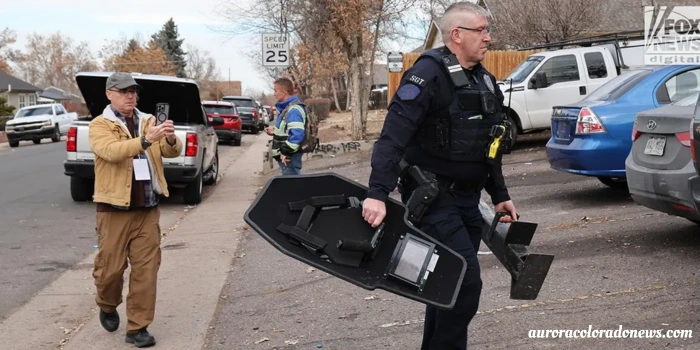AURORA, Colo. — In Colorado, local and federal law enforcement agencies struggle against the high price of identification against their violence-criminal Harbinger, the Tren de Aragua (TdA) gang. The tearing apart of a couple and their being made to suffer in an Aurora apartment complex reflects the gang’s brutality. However, law enforcement would not find it so easy to establish their links to any gang affiliation because of several convoluted reasons, including the absence of all-access identifying markers.
Difficulty In Confirming Gang Membership
Aurora Police Chief Todd Chamberlain says that in reality it is no longer difficult to confirm even blood relations with gore crime, but that’s where the real crux lies. Indeed, he says that most of the recently arrested crimes will relate to TdA, but confirming such membership is not easy. Again, it’s not too huge a leap for me to say that these individuals are TdA gang members,’ Chamberlain said when you look at the individuals involved in this, when you look at the truth and the truth of violence in this. Although he did add that this is not easy to prove, as people are being arrested for crimes that associate with gang culture and do not want to tell about their ties to organized crime.
Tren De Aragua: A Growing Threat
Even with the grave diagnosis and horrible operation, Aist radiated hope about spending Christmas with her family. “I told the doctors, ‘If you want to do it, then just do it now,’ ” she reminisced. “Because I want to be up feeling fine for the holidays. That’s one of my favorites.” The whole effort has paid off. The doctors certainly worked with Aist to provide the best recovery chances, and by December, she was preparing for the holidays, just itching to enjoy the company of her children and grandchildren.
Thus, according to the expert on organized crime at InSight Crime, Mike LaSusa, because of this lack of visible markers, it becomes difficult for the police to identify the members, given that they have tattoos or not. “They don’t necessarily have visible tattoos.” “There are really no identifiable symbols that they consistently use across the entire gang.” Instead, law enforcement has to seek other forensic measures for tracking and confirming whether an individual is indeed tied to the gang, as it did with other individuals.
Challenges In Gang Identification Across U.S. Regions
A study in the year 2020 found various methods of the U.S. law enforcement agencies to spot gang members within their networks. Western police rely on associations, past arrests, and self-admissions regarding informants. Differences in the regions where these methods are applied lead to dissimilarities in identifying and investigating gangs, which makes the fight against organized gangs even more troublesome in regions where such an environment exists, with states like Colorado being more complicated in addressing the arising problem of growing TdA presence.
The Problem With Gang Databases
It is often the case that law enforcement finds these databases most useful in tracking suspected gang members who lack obvious telltale signs, given that they include thousands of individuals arrested or tied to known gang members at the transverse local-state-federal levels. However, there has been criticism of the quality and accuracy of these databases. A 2019 report of Chicago’s inspector general showed inconsistencies of huge proportions in mislabeling individuals as gang members without a clear basis of warrant.
However, as ILRC, civil rights organizations are also campaigning on issues related to over-inclusiveness, such as putting someone in that category—reasons like associating with a gang member or residing in an identified high crime area—which usually has disproportionate effects on immigrant and low-income communities. These databases hardly ever update or delete inaccurate or old information about an individual; thus, people have been mislabeled as gang members for long periods.
Misidentification Risk And Limited Intelligence Sharing
Identifying TdA members has become a more serious hurdle with the government not cooperating with the investigators, even when they have been undergoing endless political crises in Venezuela. It is also true that, by virtue of limited access to intelligence from Venezuela, U.S. law enforcement depends entirely on their own sources, which, of course, are not perfect. That concern may even be worse because Mike LaSusa says that an individual misidentified as a TdA member may in fact not belong to the terrorist group.
Collaboration With Federal Agencies
The Aurora police are working with Homeland Security Investigations in the United States Department of Homeland Security to counter the TdA in Colorado. Chief Chamberlain knows that such efforts come with formidable challenges and difficulties, but they spur him on to work towards combating the increasing threats organized crime poses in the area. “It’s going to be a challenge—but still, we do not stop,” Chamberlain recently told a press conference.
The Ongoing Battle Against Organized Crime
It remains a weighty issue in both Aurora and Colorado regarding the continuous want of the police in identifying members belonging to organized crime, obtaining appropriate and credible intelligence, and facing all spectres of organized crime. The real complexity of gang-naming itself, the inadequacy of the gang database, and the difficulty of getting that real intelligence underscore the uphill battle in fighting law enforcement pairs against dismantling a criminal organization like Tren de Aragua. Nevertheless, the government hasn’t relented in its commitment to combating gang violence and keeping the public.



